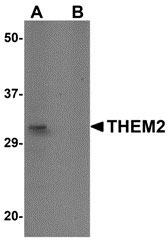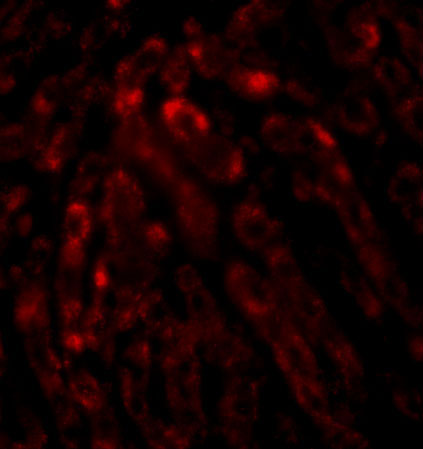THEM2 Antibody
- SPECIFICATION
- CITATIONS
- PROTOCOLS
- BACKGROUND

Application
| WB, IHC-P, IF, E |
|---|---|
| Primary Accession | Q9NPJ3 |
| Other Accession | NP_060943, 8923812 |
| Reactivity | Human, Mouse, Rat |
| Host | Rabbit |
| Clonality | Polyclonal |
| Isotype | IgG |
| Calculated MW | 14960 Da |
| Application Notes | THEM2 antibody can be used for detection of THEM2 by Western blot at 1 µg/mL. Antibody can also be used for immunohistochemistry starting at 2.5 µg/mL. For immunofluorescence start at 20 µg/mL. |
| Gene ID | 55856 |
|---|---|
| Target/Specificity | ACOT13; |
| Reconstitution & Storage | THEM2 antibody can be stored at 4℃ for three months and -20℃, stable for up to one year. As with all antibodies care should be taken to avoid repeated freeze thaw cycles. Antibodies should not be exposed to prolonged high temperatures. |
| Precautions | THEM2 Antibody is for research use only and not for use in diagnostic or therapeutic procedures. |
| Name | ACOT13 (HGNC:20999) |
|---|---|
| Synonyms | THEM2 |
| Function | Catalyzes the hydrolysis of acyl-CoAs into free fatty acids and coenzyme A (CoASH), regulating their respective intracellular levels (PubMed:16934754, PubMed:19170545). Has acyl-CoA thioesterase activity towards medium (C12) and long-chain (C18) fatty acyl-CoA substrates (By similarity) (PubMed:16934754, PubMed:19170545). Can also hydrolyze 3-hydroxyphenylacetyl-CoA and 3,4-dihydroxyphenylacetyl-CoA (in vitro) (By similarity) (PubMed:16934754, PubMed:19170545). May play a role in controlling adaptive thermogenesis (By similarity). |
| Cellular Location | Cytoplasm, cytosol {ECO:0000250|UniProtKB:Q9CQR4}. Mitochondrion {ECO:0000250|UniProtKB:Q9CQR4}. Nucleus {ECO:0000250|UniProtKB:Q9CQR4} Cytoplasm, cytoskeleton, spindle {ECO:0000250|UniProtKB:Q9CQR4} Note=During interphase, found both in the nucleus and in the cytoplasm At mitosis, localizes to the spindle. Colocalizes with tubulin {ECO:0000250|UniProtKB:Q9CQR4} |

Thousands of laboratories across the world have published research that depended on the performance of antibodies from Abcepta to advance their research. Check out links to articles that cite our products in major peer-reviewed journals, organized by research category.
info@abcepta.com, and receive a free "I Love Antibodies" mug.
Provided below are standard protocols that you may find useful for product applications.
Background
THEM2 Antibody: THEM2, also known as ACOT13, belongs to the hotdog-fold superfamily and possesses thioesterase activity, with greater activity observed with longer chain acyl-CoAs such as myristoyl- and palmitoyl-CoA. THEM2 is highly expressed in several tissues such as heart, kidney, liver and brain and has been shown to be co-localized with beta-tubulin on microtubules. THEM2 interacts with StarD, a protein that plays a key role in fatty acid metabolism, and the addition of StarD to THEM2 increased its catalytic activity, suggesting that THEM2 plays a significant role in the metabolism of fatty acids. At least two isoforms of THEM2 are known to exist.
References
Cheng Z, Song F, Shan X, et al. Crystal structure of human thioesterase superfamily member 2. Biochem. Biophys. Res. Commun.2006; 349:172-7.
Wei J, Kang HW, and Cohen DE. Thioesterase superfamily member 2 (Them2)/acyl-CoA thioesterase 13 (Acot13): a homotetrameric hotdog fold thioesterase with selectivity for long-chain fatty acyl-CoAs. Biochem. J.2009; 421:311-22.
Cheng Z, Bao S, Shan X, et al. Human thioesterase superfamily member 2 (hTHEM2) is co-localized with beta-tubulin onto the microtubule. Biochem. Biophys. Res. Commun.2006; 350:850-3.
Scappa EF, Pocai A, Wu MK, et al. Regulation of energy substrate utilization and hepatic insulin sensitivity by phosphatidylcholine transfer protein/StarD. FASEB J.2008; 22:2579-90.
If you have used an Abcepta product and would like to share how it has performed, please click on the "Submit Review" button and provide the requested information. Our staff will examine and post your review and contact you if needed.
If you have any additional inquiries please email technical services at tech@abcepta.com.













 Foundational characteristics of cancer include proliferation, angiogenesis, migration, evasion of apoptosis, and cellular immortality. Find key markers for these cellular processes and antibodies to detect them.
Foundational characteristics of cancer include proliferation, angiogenesis, migration, evasion of apoptosis, and cellular immortality. Find key markers for these cellular processes and antibodies to detect them. The SUMOplot™ Analysis Program predicts and scores sumoylation sites in your protein. SUMOylation is a post-translational modification involved in various cellular processes, such as nuclear-cytosolic transport, transcriptional regulation, apoptosis, protein stability, response to stress, and progression through the cell cycle.
The SUMOplot™ Analysis Program predicts and scores sumoylation sites in your protein. SUMOylation is a post-translational modification involved in various cellular processes, such as nuclear-cytosolic transport, transcriptional regulation, apoptosis, protein stability, response to stress, and progression through the cell cycle. The Autophagy Receptor Motif Plotter predicts and scores autophagy receptor binding sites in your protein. Identifying proteins connected to this pathway is critical to understanding the role of autophagy in physiological as well as pathological processes such as development, differentiation, neurodegenerative diseases, stress, infection, and cancer.
The Autophagy Receptor Motif Plotter predicts and scores autophagy receptor binding sites in your protein. Identifying proteins connected to this pathway is critical to understanding the role of autophagy in physiological as well as pathological processes such as development, differentiation, neurodegenerative diseases, stress, infection, and cancer.




